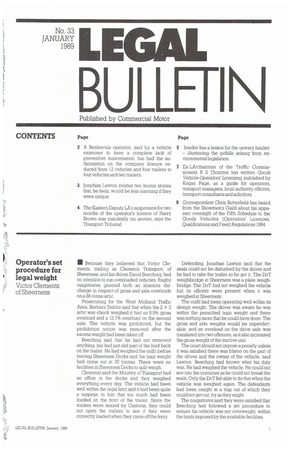Operator's set procedure for legal weight Victor Clements of Sheerness
Page 87

If you've noticed an error in this article please click here to report it so we can fix it.
• Because they believed that Victor Clements, trading as Clements Transport, of Sheerness, and his driver David Beeching, had no intention to rim overloaded vehicles, Rugby magistrates granted both an absolute discharge in respect of gross and axle overloads on a 38-tonne artic.
Prosecuting for the West Midland Traffic Area, Barbara Stubbs said that when the 2 x 3 artic was check weighed it had an 8.9% gross overload and a 12.7% overload on the second axle. The vehicle was prohibited, but the prohibition notice was removed after the excess weight had been taken off.
Beeching said that he had not removed anything, but had just slid part of the load back on the trailer. He had weighed the outfit before leaving Sheerness Docks arid the train weight had come out at 35 tonnes. There were no facilities in Sheerness Docks to split weigh.
Clements said the Ministry of Transport had an office in the docks and they weighed everything every day. The vehicle had been well within the legal limit and it had been quite a surprise to him that too much had been loaded on the front of the trailer. Since the trailers were sealed by Customs, they could not open the trailers to see if they were correctly loaded when they came off the ferry. Defending, Jonathan Lawton said that the seals could not be disturbed by the driver and he had to take the trailer as he got it. The DoT weighbridge at Sheerness was a plate weighbridge. The DoT had not weighed the vehicle but its officers were present when it was weighed at Sheerness.
The outfit had been operating well within its design weight. The driver was aware he was within the permitted train weight and there was nothing more that he could have done. The gross and axle weights would be unpredictable, and an overload on the drive axle was translated into two offences, as it also increased the gross weight of the tractive unit.
The court should not impose a penalty unless it was satisfied there was blame on the part of the driver and the owner of the vehicle, said Lawton. Beeching had known what his duty was. He had weighed the vehicle. He could not see into the container as he could not break the seals. Only the DoT felt able to do that when the vehicle was weighed again. The defendants had been caught in a trap out of which they could not get out, try as they might.
The magistrates said they were satisfied that Beeching had followed a set procedure to ensure his vehicle was not overweight, within the limits imposed by the available facilities.
































































































